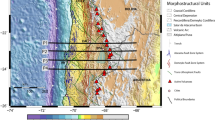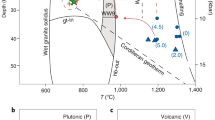Abstract
Convergent margin volcanism originates with partial melting, primarily of the upper mantle, into which the subducting slab descends1,2. Melting of this material can occur in one of two ways. The flow induced in the mantle by the slab can result in upwelling and melting through adiabatic decompression1,3. Alternatively, fluids released from the descending slab through dehydration reactions can migrate into the hot mantle wedge, inducing melting by lowering the solidus temperature2,4. The two mechanisms are not mutually exclusive1. In either case, the buoyant melts make their way towards the surface to reside in the crust or to be extruded as lava. Here we use magnetotelluric data collected across the central state of Washington, USA, to image the complete pathway for the fluid–melt phase. By incorporating constraints from a collocated seismic study5 into the magnetotelluric inversion process, we obtain superior constraints on the fluids and melt in a subduction setting. Specifically, we are able to identify and connect fluid release at or near the top of the slab, migration of fluids into the overlying mantle wedge, melting in the wedge, and transport of the melt/fluid phase to a reservoir in the crust beneath Mt Rainier.
This is a preview of subscription content, access via your institution
Access options
Subscribe to this journal
Receive 51 print issues and online access
$199.00 per year
only $3.90 per issue
Buy this article
- Purchase on Springer Link
- Instant access to full article PDF
Prices may be subject to local taxes which are calculated during checkout



Similar content being viewed by others
References
Stern, R. J. Subduction zones. Rev. Geophys. 40, 1012, http://dx.doi.org/10.1029/2001RG000108 (2002)
Davies, J. H. & Stevenson, D. J. Physical model of source region of subduction zone volcanics. J. Geophys. Res. 97 (B2). 2037–2070 (1992)
Hall, P. S. & Kincaid, C. Diapiric flow at subduction zones: a recipe for rapid transport. Science 292, 2472–2475 (2001)
Grove, T. L., Chatterjee, N., Parman, S. W. & Medard, E. The influence of H2O on mantle wedge melting. Earth Planet. Sci. Lett. 249, 74–89 (2006)
McGary, R. S. The CAFE experiment: a joint seismic and MT investigation of the Cascadia subduction system. PhD thesis, MIT/WHOI Joint Program. (2013)
Schurr, B., Asch, G., Rietbrock, A., Trumbull, R. & Haberland, C. Complex patterns of fluid and melt transport in the central Andean subduction zone revealed by attenuation tomography. Earth Planet. Sci. Lett. 215, 105–119 (2003)
Marschall, H. R. & Schumacher, J. C. Arc magmas sourced from mélange diapirs in subduction zones. Nature Geosci. 5, 862–867 (2012)
Pearce, J. A. & Peate, D. W. Tectonic implications of the composition of volcanic arc magmas. Annu. Rev. Earth Planet. Sci. 23, 251–285 (1995)
Navon, O. & Stolper, E. Geochemical consequences of melt percolation: the upper mantle as a chromatographic column. J. Geol. 95, 285–307 (1987)
Daines, M. J. & Kohlstedt, D. L. The transition from porous to channelized flow due to melt/rock reaction during melt migration. Geophys. Res. Lett. 21, 145–148 (1994)
England, P. C. & Katz, R. F. Melting above the anhydrous solidus controls the location of volcanic arcs. Nature 467, 700–703 (2010)
Mibe, K., Yoshino, T., Ono, S., Yasuda, A. & Fujii, T. Connectivity of aqueous fluid in eclogite and its implications for fluid migration in the Earth’s interior. J. Geophys. Res. 108 (B6). 2295 http://dx.doi.org/10.1029/2002JB001960 (2003)
Grove, T. L., Till, C. B., Lev, E., Chatterjee, N. & Medard, E. Kinematic variables and water transport control the formation and location of arc volcanoes. Nature 459, 694–697 (2009); erratum. 460, 1044 (2009)
Abers, G. A. et al. Imaging the source region of Cascadia tremor and intermediate-depth earthquakes. Geology 37, 1119–1122 (2009)
McNeice, G. W. & Jones, A. G. Multisite, multifrequency tensor decompositions of magnetotelluric data. Geophysics 66, 158–173 (2001)
Groom, R. W. & Bailey, R. C. Decomposition of magnetotelluric impedance tensors in the presence of local three-dimensional galvanic distortion. J. Geophys. Res. 94, 1913–1925 (1989)
Rodi, W. L. & Mackie, R. L. Nonlinear conjugate gradients algorithm for 2-D magnetotelluric inversion. Geophysics 66, 174–187 (2001)
Wannamaker, P. E. et al. Resistivity cross section through the Juan de Fuca subduction system and its tectonic implications. J. Geophys. Res. 94, 14127–14144 (1989)
Soyer, W. & Unsworth, M. Deep electrical structure of the northern Cascadia (British Columbia, Canada) subduction zone: implications for the distribution of fluids. Geology 34, 53–56 (2006)
Evans, R. L., Wannamaker, P., McGary, R. S. & Elsenbeck, J. Electrical structure of the Central Cascadia subduction zone: the EMSLAB Lincoln line revisited. Earth Planet. Sci. Lett http://dx.doi.org/10.1016/j.epsl.2013.04.021 (in the press)
Meqbel, N. M., Egbert, G. D., Wannamaker, P. E., Kelbert, A. & Schultz, A. Deep electrical resistivity structure of the northwestern U.S. derived from 3-D inversion of USArray magnetotelluric data. Earth Planet. Sci. Lett. http://dx.doi.org/10.1016/j.epsl.2013.12.026 (in the press)
John, T. & Schenk, V. Partial eclogitization of gabbroic rocks in a late Precambrian subduction zone (Zambia): prograde metamorphism triggered by fluid infiltration. Contrib. Mineral. Petrol. 146, 174–191 (2003)
McCrory, P. A., Blair, J. L., Waldhauser, F. & Oppenheimer, D. H. Juan de Fuca slab geometry and its relation to Wadati-Benioff zone seismicity. J. Geophys. Res. 117, B09306 (2012)
Ni, H., Keppler, H. & Behrens, H. Electrical conductivity of hydrous basaltic melts: implications for partial melting in the upper mantle. Contrib. Mineral. Petrol. 162, 637–650 (2011)
van Keken, P. E., Hacker, B. R., Syracuse, E. M. & Abers, G. A. Subduction factory: 4. Depth-dependent flux of H2O from subducting slabs worldwide. J. Geophys. Res. 116, B01401 (2011)
Zhu, W., Gaetani, G. A., Fusseis, F., Montesi, L. G. J. & De Carlo, F. Microtomography of partially molten rocks: three-dimensional melt distribution in mantle peridotite. Science 332, 88–91 (2011)
Defant, M. J. & Drummond, M. S. Derivation of some modern arc magmas by melting of young subducted lithosphere. Nature 347, 662–665 (1990)
Stockstill, K. R., Vogel, T. A. & Sisson, T. W. Origin and emplacement of the andesite of Burroughs Mountain, a zoned, large-volume lava flow at Mount Rainier, Washington, USA. J. Volcanol. Geotherm. Res. 119, 275–296 (2003)
Egbert, G. D. & Booker, J. R. Imaging crustal structure in southwestern Washington with small magnetometer arrays. J. Geophys. Res. 98 (B9). 15967–15985 (1993)
Worzewski, T., Jegen, M., Kopp, H., Brasse, H. & Castillo, W. T. Magnetotelluric image of the fluid cycle in the Costa Rican subduction zone. Nature Geosci. 4, 108–111 (2011)
Chave, A. D. & Thompson, D. J. Bounded influence magnetotelluric response function estimation. Geophys. J. Int. 157, 988–1006 (2004)
Egbert, G. D. Robust multiple station magnetotelluric data processing. Geophys. J. Int. 130, 475–496 (1997)
Caldwell, T. G., Bibby, H. M. & Brown, C. The magnetotelluric phase tensor. Geophys. J. Int. 158, 457–469 (2004)
Simpson, F. & Bahr, K. Practical Magnetotellurics 93–98 (Cambridge Univ. Press, 2005)
Patro, P. K. & Egbert, G. D. Regional conductivity structure of Cascadia: preliminary results from 3D inversion of USArray transportable array magnetotelluric data. Geophys. Res. Lett. 35, L20311 (2008)
Matsuno, T. et al. Upper mantle electrical resistivity structure beneath the central Mariana subduction system. Geochem. Geophys. Geosyst. 11, Q09003 (2010)
Acknowledgements
We thank V. Maris, M. Brown, A. Kelbert, and Quantec Geoscience, Inc. for their part in data acquisition. We also thank A. Pommier, D. Lizarralde, A. Malcolm, A. Shaw, H. Marschall and J. P. Canales for critical discussions and input on early versions of the manuscript. Finally, we thank P. van Keken for use of his thermal overlay in the magnetotelluric figure. This work was supported by US National Science Foundation grant EAR08-44041 (Principal Investigator R.L.E.) and US National Science Foundation grant EAR08-43725 (Principal Investigator P.E.W.), both through the Earthscope programme. R.S.M. was supported by a National Defense Science and Engineering Graduate (NDSEG) fellowship.
Author information
Authors and Affiliations
Contributions
R.L.E. and P.E.W. conceived the experiment. R.S.M. participated in data collection and was primarily responsible for the processing and inversion work and analysis. R.L.E. was involved in all aspects of the development of the magnetotelluric models. P.E.W. coordinated and led the data collection, and also performed some of the processing and analysis of the broadband data. J.E. assisted with data reduction and processing. S.R. was involved in the production of the seismic image. All authors contributed to the understanding of the results and editing of the manuscript.
Corresponding author
Ethics declarations
Competing interests
The authors declare no competing financial interests.
Extended data figures and tables
Extended Data Figure 1 Rose diagram showing overall strike directions.
The colour code reflects the Bahr skew as determined using the STRIKE algorithm15 for the CAFE data set.
Extended Data Figure 2 Primary standard inversion images for the CAFE data.
These magnetotelluric images were generated without incorporating a tear zone on top of the slab or setting the initial resistivity for the slab. The top image was generated using a combination of the TM mode and tipper, whereas the bottom image was produced using the TM and TE modes along with the tipper.
Extended Data Figure 3 The TM (a) and TE (b) pseudo-sections for the CAFE magnetotelluric data.
The two upper panels in a and the two upper panels in b show apparent resistivity and phase for the data. The two lower panels in a and the two lower panels in b show apparent resistivity and phase for the model. Both models are limited horizontally to correspond with the surface covered by the CAFE magnetotelluric array.
Extended Data Figure 4 Plot of root-mean-square misfit against the 60 CAFE magnetotelluric stations for the TM/TE/tipper models.
The blue line shows root-mean-square misfit by station for the halfspace model (without a tear or initial resistivity set for the upper slab), and the green line shows the same for the augmented model (using a tear at the top of the slab and imposing initial resistivity for the upper part of the slab). The overall root-mean-square misfit values were 3.08 for the halfspace model, and 1.89 for the augmented model.
Rights and permissions
About this article
Cite this article
McGary, R., Evans, R., Wannamaker, P. et al. Pathway from subducting slab to surface for melt and fluids beneath Mount Rainier. Nature 511, 338–340 (2014). https://doi.org/10.1038/nature13493
Received:
Accepted:
Published:
Issue Date:
DOI: https://doi.org/10.1038/nature13493
This article is cited by
-
Fluid transport and storage in the Cascadia forearc influenced by overriding plate lithology
Nature Geoscience (2022)
-
Venus’ light slab hinders its development of planetary-scale subduction
Nature Communications (2022)
-
Audio-Magnetotelluric Modeling for 2D Characterization of Shallow Sedimentary Basins and Groundwater System in Central Zagros, Iran
Pure and Applied Geophysics (2022)
-
Magma reservoir beneath Azumayama Volcano, NE Japan, as inferred from a three-dimensional electrical resistivity model explored by means of magnetotelluric method
Earth, Planets and Space (2021)
-
Correlation of porosity variations and rheological transitions on the southern Cascadia megathrust
Nature Geoscience (2021)
Comments
By submitting a comment you agree to abide by our Terms and Community Guidelines. If you find something abusive or that does not comply with our terms or guidelines please flag it as inappropriate.



